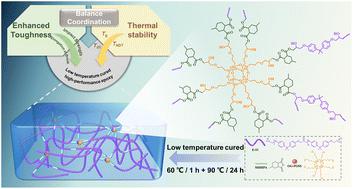Our official English website, www.x-mol.net, welcomes your
feedback! (Note: you will need to create a separate account there.)
低粘度、低温固化反应性POSS/环氧杂化树脂,具有增强的韧性和综合热性能
RSC Advances ( IF 3.9 ) Pub Date : 2024-03-01 , DOI: 10.1039/d3ra08390j
Ruiyan Han 1 , Xiaoyan Ma 1 , Lifeng Cai 1 , Zongwu Zhang 1 , Yiliang Fang 1 , Jian Wang 1
Affiliation

|
低温固化( T固化≤100℃)的环氧树脂的机械性能和耐高温性能往往较差,而大多数环氧树脂的增韧改性方法往往会损害耐热性,这极大地限制了其实际应用。因此,本工作报道了一种低粘度低温固化环氧杂化树脂体系(OPEP),采用E-51作为树脂基体,液体酸酐(MHHPA)作为固化剂,叔胺(DMBA)作为固化促进剂,和反应性八环氧基封端的多面体低聚倍半硅氧烷(OG-POSS)作为增韧改性剂。结果表明,OPEP体系具有优异的加工性能,粘度低,加工窗口期长,满足低温固化的实际要求。 OG-POSS与树脂基体表现出优异的相容性和反应活性,其添加略微降低了固化反应的Eα ,对环氧树脂的固化有一定的促进作用。此外,OPEP树脂的固化反应速率符合Šesták-Berggren自催化动力学模型。 OPEP树脂的冲击强度、弯曲强度、拉伸强度和断裂伸长率分别达到最大值15.55 kJ m -2 、121.65 MPa、90.36 MPa和2.48%,分别提高了55.97%、3.1%、64.68%,与纯树脂相比,分别提高了 26.51% 和 26.51%。 值得注意的是,由于OG-POSS的耐热无机硅笼结构,OPEP 0.02树脂的热分解温度( T d5 )、玻璃化转变温度( T g )和热变形温度( T HDT )为313.2° C、123.7℃和102.0℃,与纯树脂相比分别提高了13.0℃、2.3℃和6.8℃,这是一般热固性树脂增韧改性方法难以实现的。该研究利用有机-无机纳米杂化材料(POSS)协调优化树脂的韧性和热稳定性,为制备低温固化的高性能环氧树脂提供指导。

"点击查看英文标题和摘要"

































 京公网安备 11010802027423号
京公网安备 11010802027423号